We use cookies on this site to enhance your experience.
By selecting “Accept” and continuing to use this website, you consent to the use of cookies.
Search for academic programs, residence, tours and events and more.
The Centre for Cold Regions and Water Science (CCRWS) is a collaborative research facility that houses four research centres/groups and a variety of state-of-the-art analytical equipment. The facility, which opened in 2013, is funded by Laurier, the Government of the Northwest Territories, the Canada Foundation for Innovation, the Ontario Ministry of Research and Innovation, and the Federal Economic Development Agency for Southern Ontario.
CCRWS is home to two interdisciplinary Laurier research centres and two collaborative research groups.
CCRWS analytical equipment is available to internal and external users. Access policies and fees may vary by user type – for details, contact Gena Braun. User types are defined as follows:
The Faculty of Science research instrumentation technicians will provide initial training for all new internal or external users preceding first use. New users cannot be given initial training by other users or students. Contact Gena Braun to schedule training.
User fees have been created to offset the costs of instrument operation and maintenance. Contact Gena Braun for the current fee schedule.
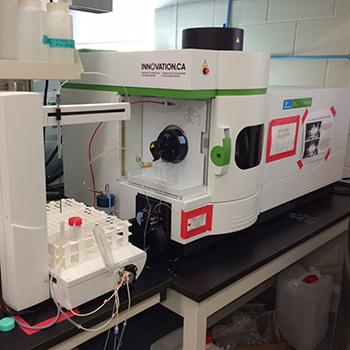 Perkin Elmer Optima 8000 ICP-OES
Perkin Elmer Optima 8000 ICP-OESThe Optima 8000 ICP-OES is a dual view instrument, allowing for determination of both high and low concentrations in the same method. Use of compressed air as a shear gas removes the plasma tail plume, which eliminates many interferences and minimizes the need for the addition of ionization suppressants. The photons generated within the plasma are measured by a CCD array detector.
This ICP can measure almost all of the elements in the periodic table sequentially within a single sample. The dynamic range of measurement is element and matrix dependent, but typically ranges from tens of ppb (mg/L) to hundreds of ppm (mg/L).
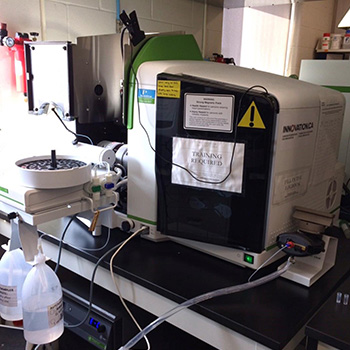 Perkin Elmer PinAAcle 900T AA
Perkin Elmer PinAAcle 900T AAThe PinAAcle spectrometer allows for both flame and transversely-heated graphite furnace atomization, enabling the analysis of a wide range of sample concentrations. The furnace camera simplifies pyrolysis method development. This system is currently equipped with lamps for Ag, Al, Ca, Cd, Cu, Fe, Hg, K, Mg, Na, Ni, Pb, Rb, Ti and Zn.
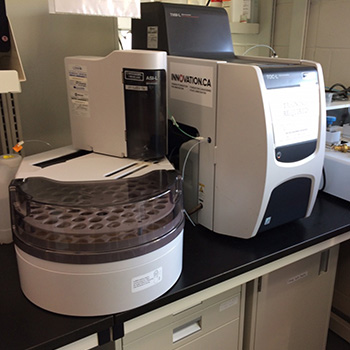 Shimadzu TOC-LCPH Total Organic Carbon and Nitrogen Analyzer with Solid Sampling Module
Shimadzu TOC-LCPH Total Organic Carbon and Nitrogen Analyzer with Solid Sampling ModuleThe Shimadzu can be used to analyze a variety of carbon species and total nitrogen (TN) in liquid or solid samples using catalytic oxidation up to 680 degrees Celsius. Carbon can be assessed as total carbon (TC), organic carbon (TOC), non-purgable organic carbon (NPOC) and inorganic carbon (IC). This instrument is equipped with an ASI-L autosampler.
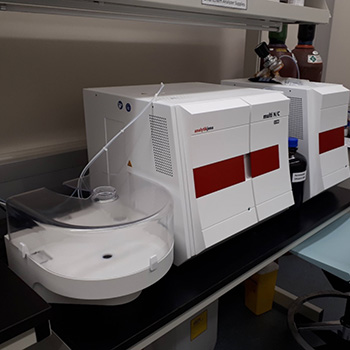 Analytic Jena NC3100
Analytic Jena NC3100The NC3100 can also be used to analyze a variety of carbon species and total nitrogen (TN) in liquid or solid samples using catalytic oxidation up to 950 degrees Celsius. Carbon can be assessed as total carbon (TC), organic carbon (TOC), non-purgable organic carbon (NPOC) and inorganic carbon (IC). This instrument is equipped with an AS Vario autosampler.
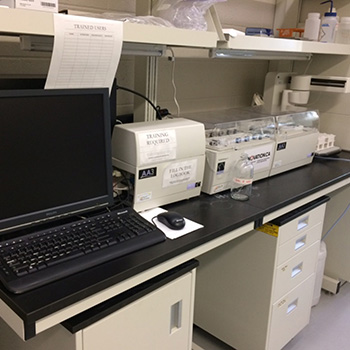 SEAL Continue Flow AutoAnalyzer 3
SEAL Continue Flow AutoAnalyzer 3The AutoAnalyzer can test for phosphate and ammonia using continuous flow colorimetry. It is equipped with a 120 vial autosampler, a high precision pump, two manifolds and a digital colorimeter with detection limits reaching 0.2 mg/L. The internal diameter of the glassware is two mm, which allows complex and non-homogeneous samples to be run without clogging. Roughly 50 samples can be run per hour with a minimum volume of three ml.
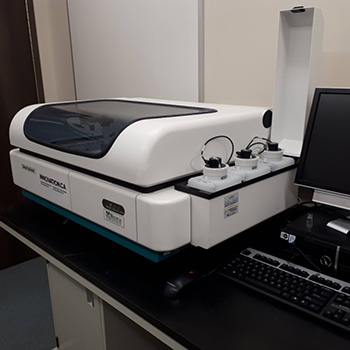 SmartChem Discrete Analyzer
SmartChem Discrete AnalyzerThe SmartChem autoanalyzer can be used to determine ppm nutrient concentrations and can analyze up to 200 samples per hour. It is currently equipped with methods for testing alkalinity, ammonia, chloride, cyanide, harness, nitrate, nitrite, phenol, phosphorous, silica, sulfate and TKN.
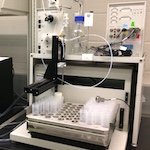 The Mantech AssayPlus system is an automated multi-parameter ion-analysis system. It has a TitraSip module and a 73 position autosampler that holds 50-ml tubes. The system is currently equipped with ion selective electrodes for the analysis of ammonia, copper, chloride, lead, nitrate, potassium and sodium. The system is controlled by PC Titrate software.
The Mantech AssayPlus system is an automated multi-parameter ion-analysis system. It has a TitraSip module and a 73 position autosampler that holds 50-ml tubes. The system is currently equipped with ion selective electrodes for the analysis of ammonia, copper, chloride, lead, nitrate, potassium and sodium. The system is controlled by PC Titrate software.
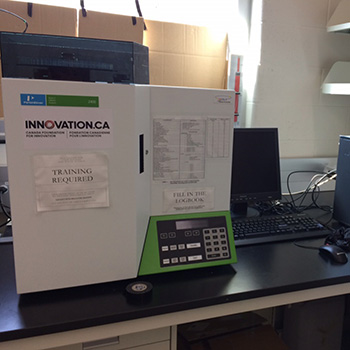 Perkin Elmer 2400 CHNS Analyzer
Perkin Elmer 2400 CHNS AnalyzerUsing the Pregl-Dumas combustion method, the 2400 elemental analyzer can determine the weight percent carbon, hydrogen, nitrogen or sulfur in a variety of sample types, with an analytical range of 0.001 to 3.6 mgs (element dependant). The 60 position autosampler allows for automated analysis, and the data is collected by the data management software.
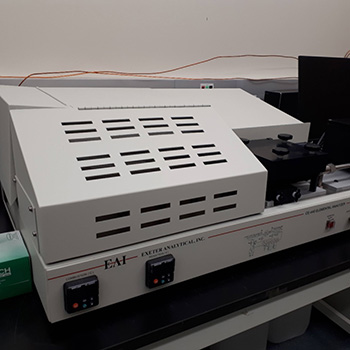
The CE 440 can be used to measure carbon, hydrogen, and nitrogen, after combustion and reduction and using thermal conductivity. A variety of sample types can be analyzed and only a few mg of sample are required for analysis. This instrument offers lower per-cost sample analysis and a horizontal injector that reduces residue build-up and interferences.
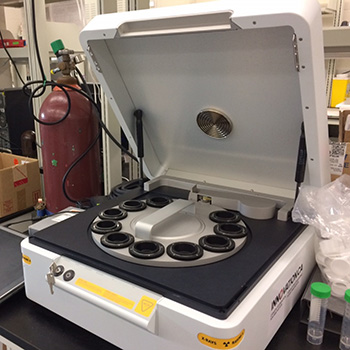 Panalytical Epsilon 3 Benchtop EDXRF
Panalytical Epsilon 3 Benchtop EDXRFThe energy dispersive x-ray fluorescence spectrometer is used to determine the concentration of elements from sodium to americium in a wide variety of sample types. It performs non-destructive analysis with ppm level detection limits. The sample turntable holds 10 samples with diameters from 25 to 52 mm.
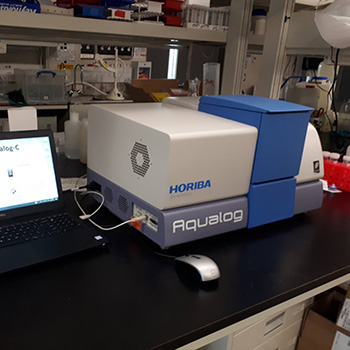
The Aqualog fluorescence spectrometer is uniquely designed to facilitate the analysis of dissolved organic matter using fast excitation-emission detection and can also be used to collect 2D absorbance scan data. The Aqualog excitation range is from 200 to 600 nm and uses a xenon lamp excitation source.
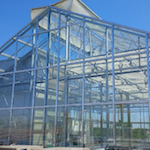 The Centre for Cold Regions and Water Science boasts a large rooftop greenhouse. Contact Gena Braun for greenhouse policies.
The Centre for Cold Regions and Water Science boasts a large rooftop greenhouse. Contact Gena Braun for greenhouse policies.
Contact Us:
Gena Braun, Research Instrumentation Technician
E: gbraun@wlu.ca
T: 519.884.0710 x2484
F: 519.884.0464
Office Location:
Centre for Cold Regions and Water Science, CRW206A, Waterloo campus
Office Hours:
Tuesday-Thursday, 8 a.m. – 3 p.m.